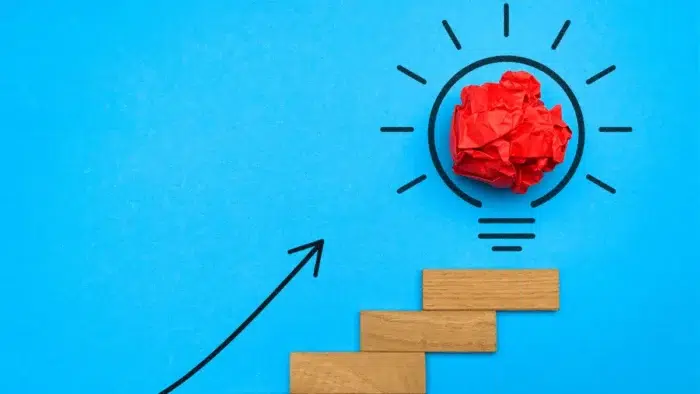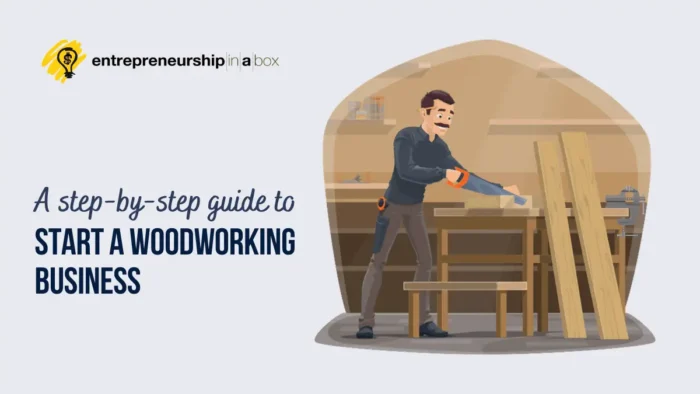Why should you validate the business idea? Testing your ideas early in development is important when exploring new products or business concepts. Here is the ultimate guide that will lead you through the whole process when you want to validate your business or startup idea.
Validation is not relevant only to potential entrepreneurs and future startups. Existing companies also need to prove the concept of the initial business idea. They must validate their ideas to analyze their potential impact on the organization’s goals.
According to extensive research, one of the biggest reasons for business failure is the lack of a market need for a product. So, you cannot have a business if no one wants your product or service.
As someone who works with entrepreneurial individuals, I’ve discovered that most have endless ideas. However, most of them keep their ideas only to themselves. They are afraid that if anyone hears about their ideas, they will use them to create their company and succeed.
If you keep your ideas only for yourself, you cannot validate them, and you will probably fail.
Now, let’s start with the practical steps you must take to validate your business idea or create your business validation plan.
📖 Key takeaways
- Before you start the idea validation process, you must define your target market and develop the first draft of your business model—or versions if you have several business models you want to test and validate.
- If you validate your business idea first, you will not have reasons to be scared that your new venture will fail.
- For each idea, you must first validate the market. Is there a big enough market with people starving and willing to pay for the solution? Next, you must respond to the question: Is it worth spending time, money, and effort implementing the idea? In the end, you must check if there are customers who purchase your solution.
Before You Start With Idea Validation
When you decide to validate your product idea, you must prepare yourself.
Here are the steps you must take:
1. Develop Your Business Concept
First, you must translate your new business idea into a business concept that is wider than the product concept because you will not only describe the product or service itself but also define your initial target market, business model, Unique Value Proposition (UVP), competition, etc.
You can find more details on how to develop a creative business concept that stands out.
2. Conduct Market Research to Assess Your Target Market Size
Now, when you have documented your business concept, you can perform market research.
There are several important questions you must respond to:
- Who is your target market and audience for your products and services?
- What is the total addressable market, the served available market, and the target market? Read more in “How to Identify the Right Target Market for Your Startup” for steps and examples of defining all three markets.
- What problems or pain points are you trying to solve?
- How those pain points are currently solved on the market? What are existing solutions?
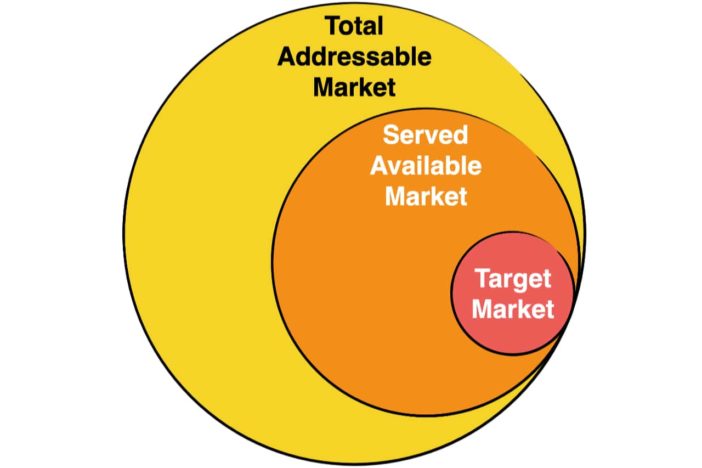
3. Develop the Business Model for Your Idea Validation
The second step is to develop your business model and write down your business hypotheses and validation goals.
At this stage, your business hypotheses must be defined for value proposition, customer segments, channels, customer relationships, and possible revenue streams.

Idea Validation Frameworks – How to Validate Business Idea?
Now, you need to create a process for validating ideas or testing business ideas for viability.
In this guide, I will use a specific idea validation framework that I use with my clients. But remember that you will need to tweak it according to your own needs. The processes we will cover here are based on lean market validation. So, here you will find useful and practical information to help you do the work yourself.
Let’s start by simply breaking down the whole process into three different stages:
- Market validation stage
- Idea validation stage
- Product validation stage
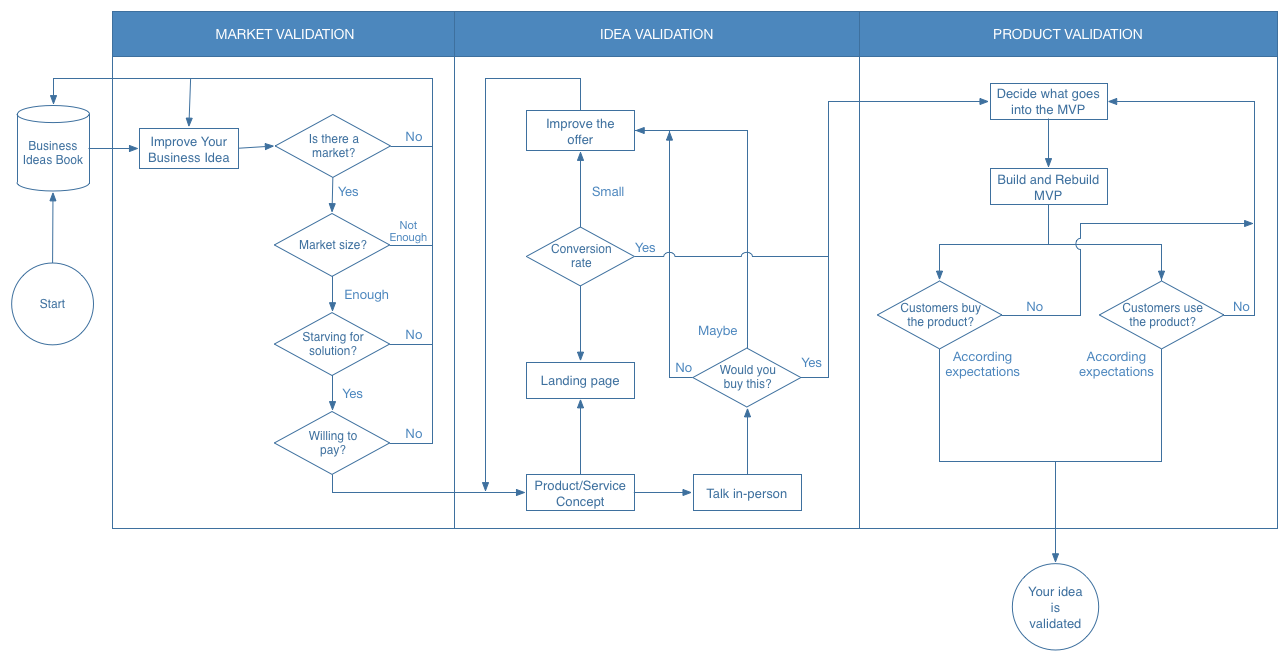
Don’t worry. I will explain all three stages in this post. First, open your business ideas book or use these 50 questions to develop a business idea or generate business ideas that match your skills. Maybe you have already found the gap in an established market so that you can use this business idea. It doesn’t matter how you find a business idea. It is more important to have a business idea you want to validate.
1. Market validation stage
Market validation is the first stage of your validation process. If your idea passes this stage, you can proceed to the next stages.
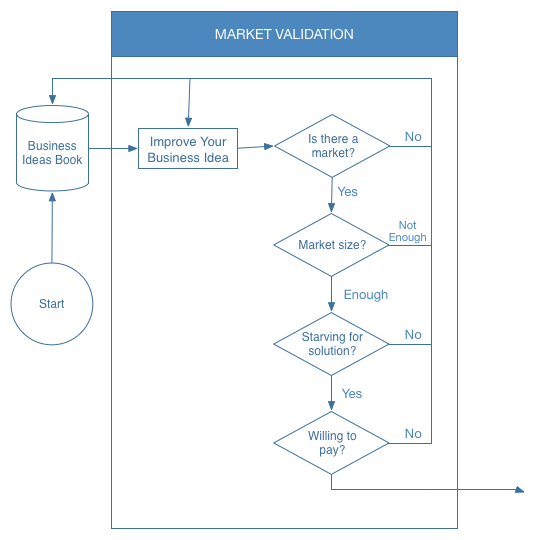
The purpose of the market validation stage is to find the answers to the following important questions:
- Is there a market for the product due to your business idea?
- If there is a market, is it big enough?
- Are people on the market starving for the solution to the problem your product will solve?
- Are they willing to pay for such a solution?
I will share some tools and steps you will need to find answers to these questions based on facts, not assumptions.
Related: 5 Benefits of Using People Search Engine
1. Use Google Trends to research and validate the business idea
You can start your market validation with Google Trends to see the trend when people search for a solution that your business idea will produce for them. Google Trends is based on Google Search and shows how often a particular search term is used by real people when searching something on Google relative to the total search-volume across various regions of the world and in various languages.
Let’s say that we will base our product on Chia seeds. I will go to Google Trends and type in the search term Chia seeds in such a case. The results based on search volume are shown in the picture below.
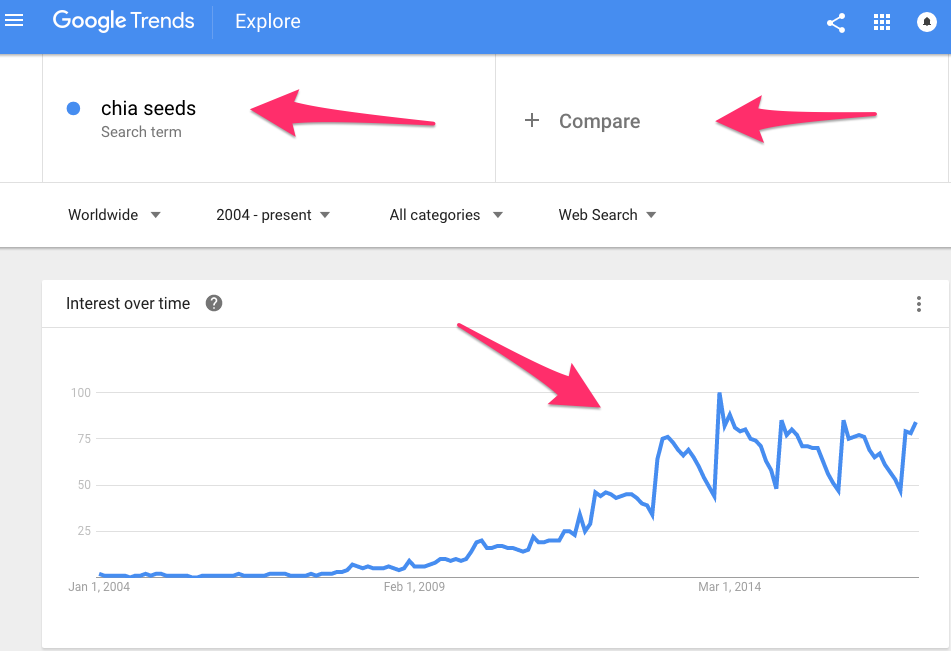
According to Google searches, we have a growth trend in Chia seeds. You can see that, according to Google, each year is the biggest interest in January, while in December, we have substantial declines in search trends.
Congratulations, you come to an important fact when you validate a business idea!
But, I want to be more specific because I want to produce Chia seed oil or Chia seed powder. So, let’s compare these two terms in Google Trends.
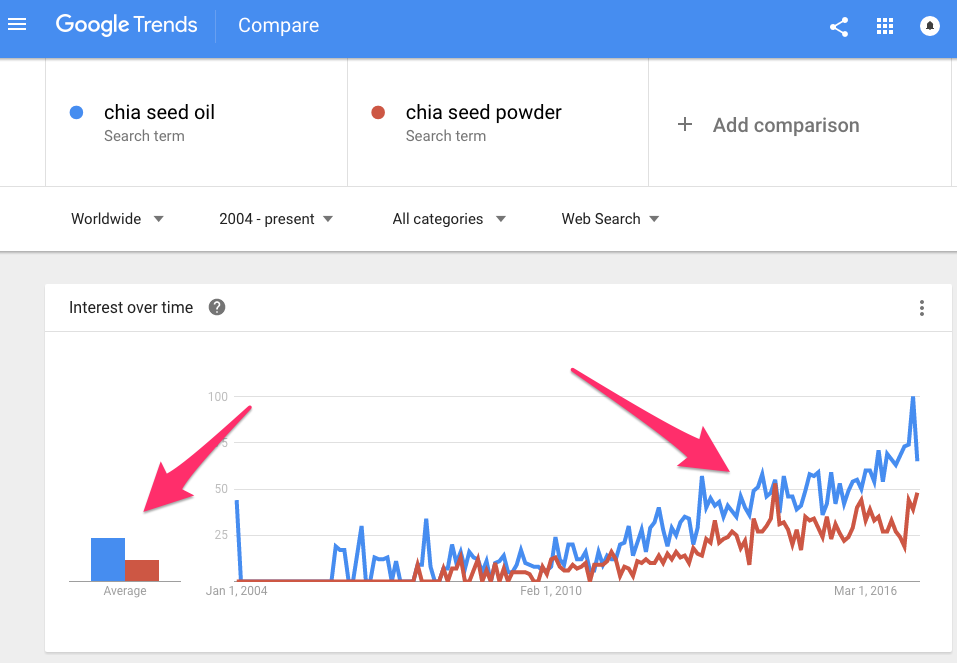
As you can see from the results, Chia seed oil is more popular than Chia seed powder. This result is an additional sign of a market for two products, but the demand for Chia seed oil is higher than for Chia seed powder.
You can dig deeper by analyzing the interests of regions or cities or looking at related rising queries.
2. Use Google Keyword Planner to research and validate your ideas
We can continue our research for market validation of our business idea to produce products from Chia seeds. Let’s use the Google Keyword Planner tool to research search volume and related terms about our two most important keywords: Chia seed oil and Chia seed powder.
Go to Google Keyword Planner and search for new keywords using the phrase, website, or category.
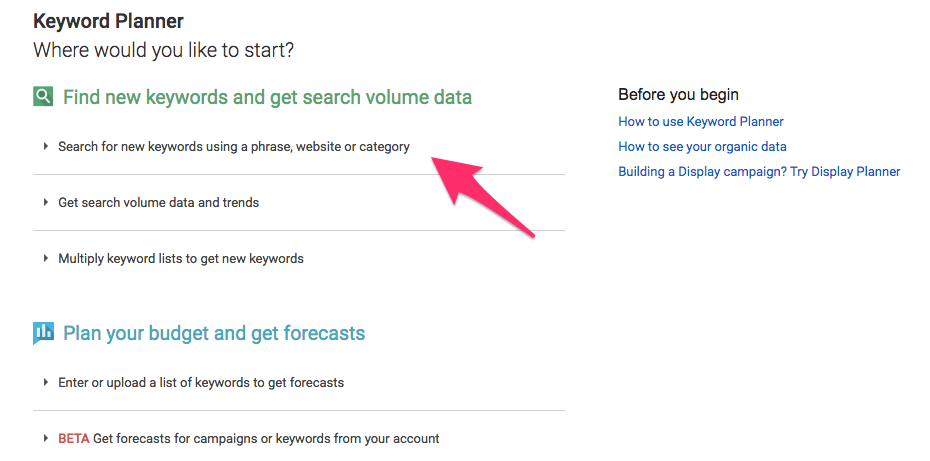
Next, you must put your keywords in the picture below and click “Get Ideas.”
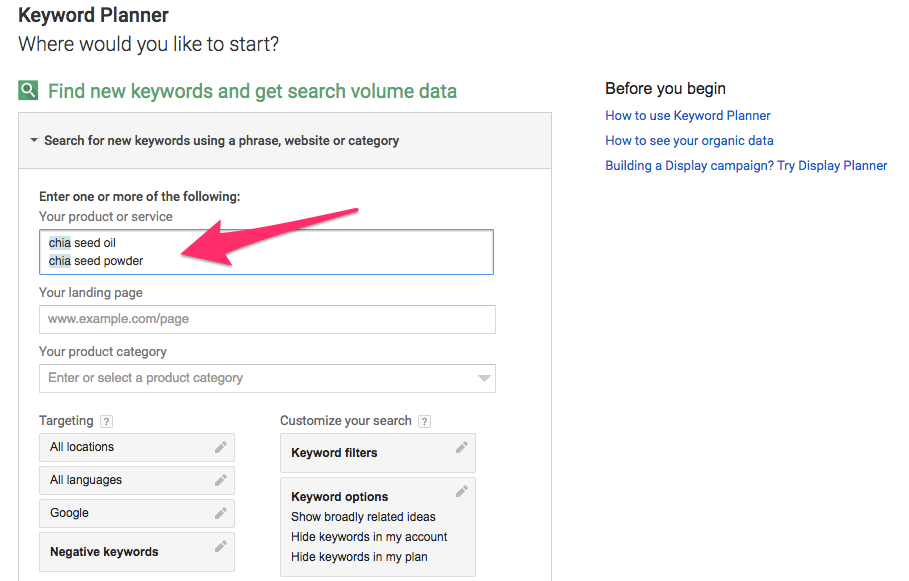
The results I get for my “Chia seeds” business idea are the following:
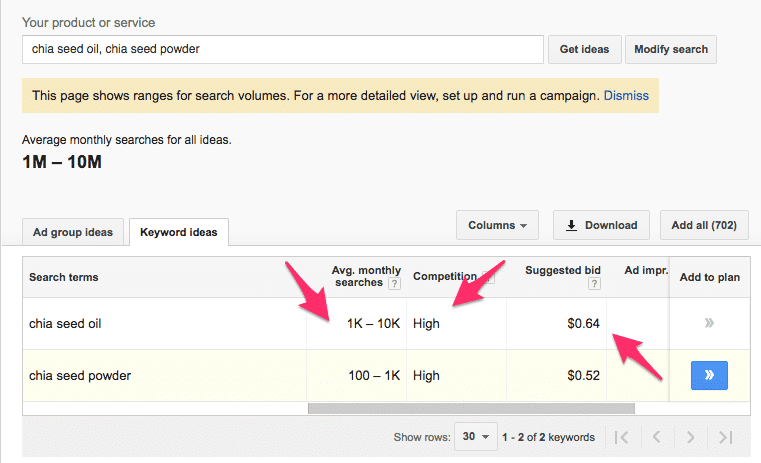
As you can see, Chia seed oil has ten times more searches than Chia seed powder. Also, there is high competition for both keywords. This result is a great sign for our purpose because we are in the market validation stage.
If there is no competition, there may be no market for such a product. Another important fact tells us if there is a market for Chia seed oil and powder. If you look at the “suggested bid” column, you can see that Chia seed oil has a higher suggested bid, so companies pay more to advertise Chia seed oil than powder. Again, this result is another sign that we have a market for both products.
As shown in the picture below, I will continue researching to check for other similar suggestions.
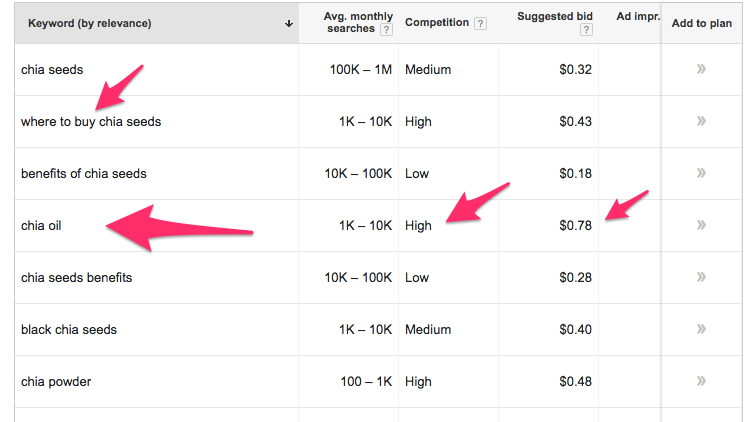
From these results, I can see another term closely related to my primary keyword – Chia oil. Also, something important for this stage of the validation process is that there are several results for keywords containing where to buy, confirming that the Chia seeds’ niche is the right niche for our business.
3. Use Amazon to research and validate ideas
You can use Amazon to check if a market is big enough for your business idea. Why Amazon, you probably ask? It is similar to search engines, where people search for something; in this case, they search for products they want to buy.
Go to Amazon.com and type in your target keyword that your target customers will use or niche related to your business idea in the search bar. For example, if my target keyword is “Chia seeds,” I will get these results.
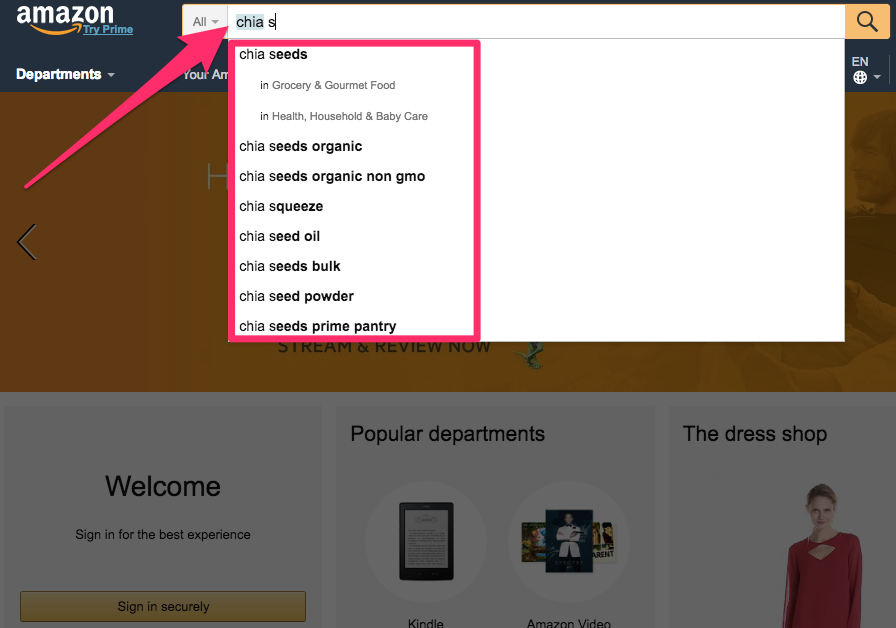
As we can see from the results, people can buy many possible products related to chia seeds, like “Chia seed oil” and “Chia seed powder.” If I continue to write about Chia seed oil, I will get additional, more specific products such as:
- Chia seed oil for skin
- Chia seed oil capsules
- Chia seed oil supplement
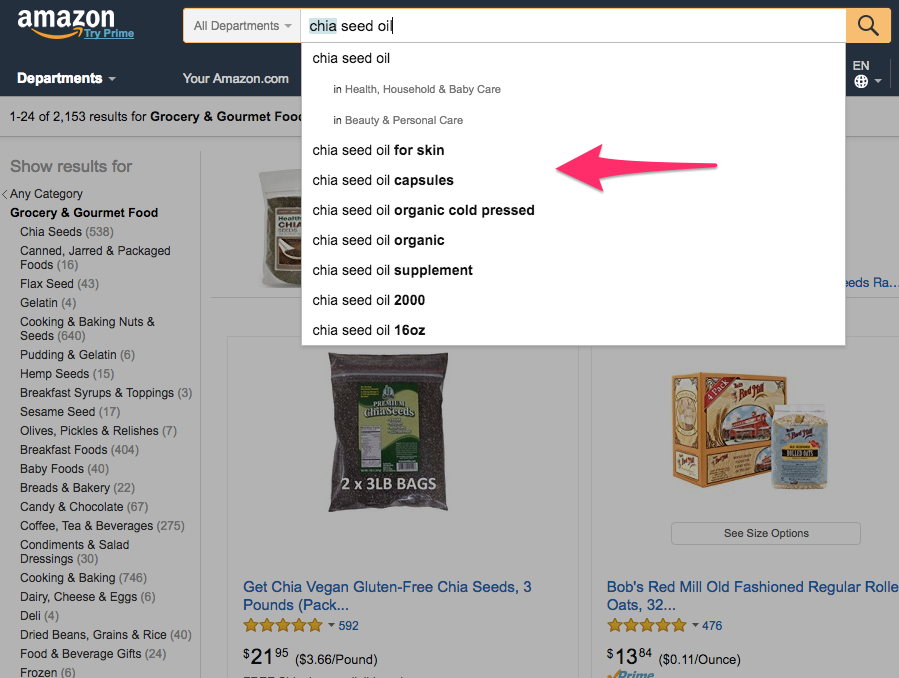
So, these can be some specific types of products that my business idea will generate if it passes the validation process.
But I will continue my research on Amazon. I want to search for different products that contain Chia seed oil. In the Amazon search box, I will write “Chia seed oil” in quotation marks to get an exact match with the words in quotes (see picture below).
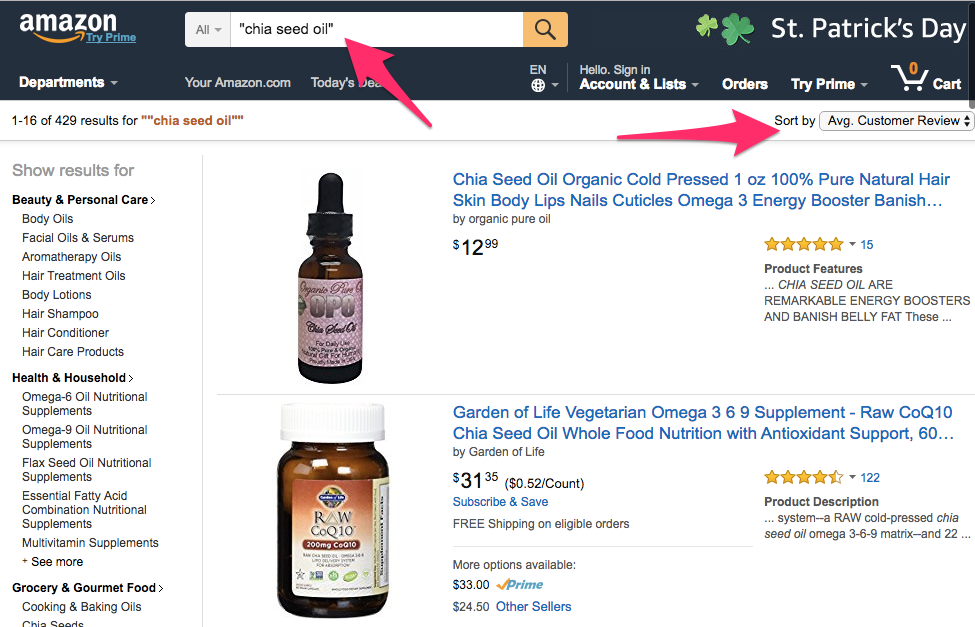
We can see that there are many different products related to Chia seed oil. This result is proof that we have a market for our business idea. But let’s dig deeper to find more insights.
I have sorted the results according to the average customer review, so the best products come first. Now, it is time to work on research.
Open products from the list one by one and look at the following sections: “about the product,” “product description,” “frequently bought together,” “customers who bought this item also bought,” “Customer Questions & Answers,” and “Customer Reviews.”
Look at the “about the product” section and write what you see on a piece of paper or an Excel (or Google Drive) spreadsheet. You will need this information later because you can use this copy of some of the best products reviewed on Amazon when you need to design your total offer at this stage.
You can also analyze the package from a copy of some of the best products reviewed on Amazon when you need to design your total offer as a part of idea validation.
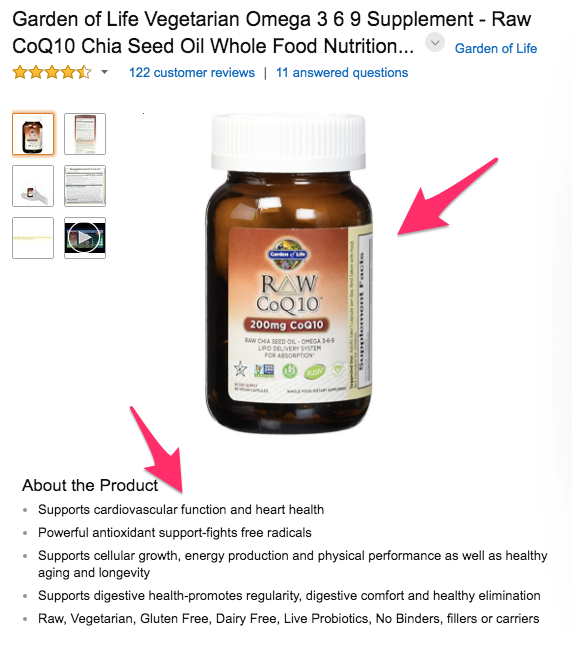
Next, look at the product description and see how it is described to potential customers on Amazon. Again, write this information down and use it when you design your offer.

When you look at the “frequently bought together” and “customers who bought this item also bought,” you will see some related products you can use in the future.
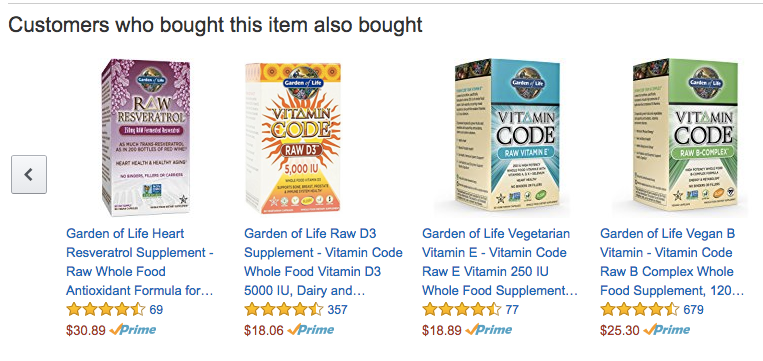
Next, look at the section “Customer Questions & Answers” and read all the questions and answers. If there are many questions, this is an additional sign of the market’s existence. You will also find useful information on the biggest customers’ problems, challenges, and concerns that you can use to develop the product when you move through the stages of the validation process.
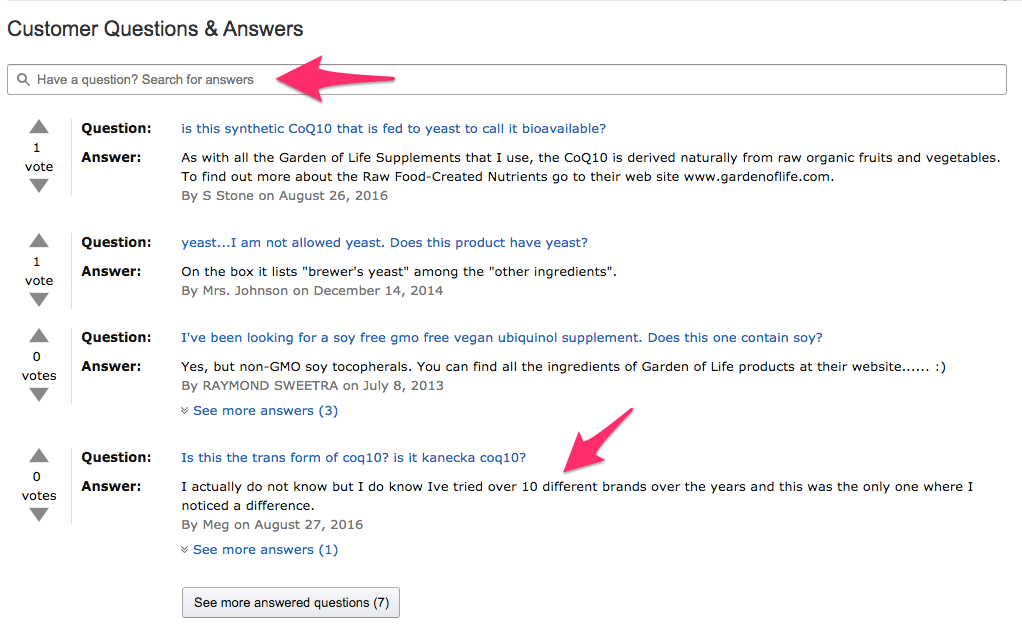
When you look at “Customer Reviews,” you can find additional information about what customers like, dislike, and how the product helped them. You can also look closely at the lowest review ratings to see what the customers are complaining about. Consider the possible solution you can include in your product to avoid such complaints.
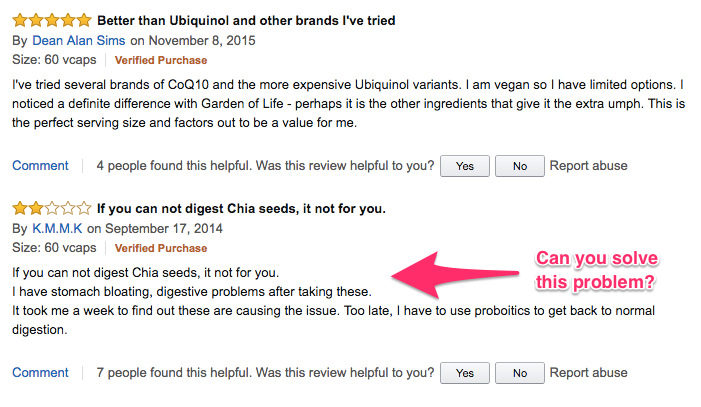
Don’t forget to write all the things that you find while you conduct this research. It will be helpful in the next stages of the development of your business.
4. Create the survey with Google Drive
You have already collected many interesting answers and analyses. Now, you can go one step further and start gathering information directly from prospective customers about the market. The best way to do this in the market validation stage is to use a survey.
Log in to your Google account and open Google Forms.
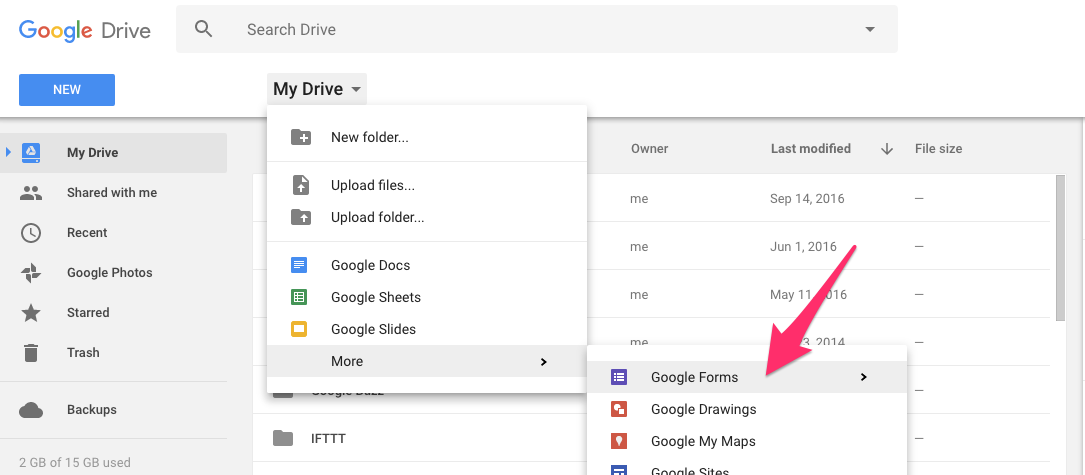
You can now start creating your survey using the recommendations I will share below.
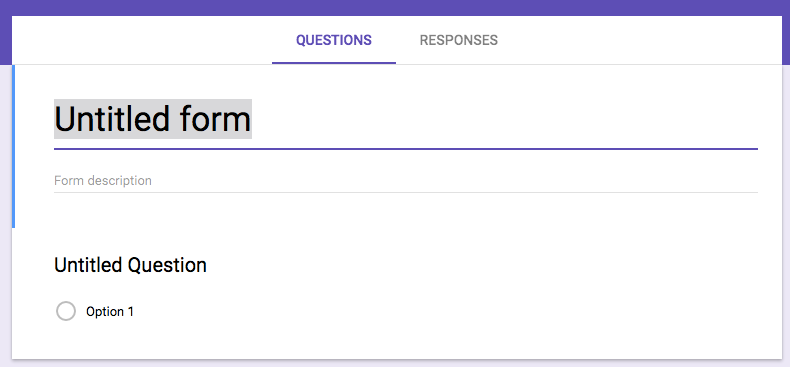
When you survey your target market segment for market validation purposes, you cannot use structured questions with already prepared answers so that potential customers from the market will choose one or several of them. You want to validate the market, or existence of the market, the possible size of the market, the presence of starving potential customers for the solution, and their willingness to pay for your solution.
Your survey will be structured only in two parts containing several open-ended questions. The first part is about the market and customers. With these questions, you aim to identify your market more accurately to segment your target audience. In this part of your survey will be questions like:
- How can you describe yourself concerning (market, problem, solution)?
- What is your profession?
Use open-ended questions in the survey when it comes to describing the problem and possible solutions.
- What is your single biggest challenge/frustration with _________?
- How do you currently solve this problem?
- Do you want a solution that will solve this problem?
- How many times will you use this type of solution?
- What does the solution need to give you to pay for it?
- How much will you pay for the complete solution, and why?
- How much will you pay for the partial solution, and why?
When you finish creating your survey with Google Forms, you can send it to potential customers. You can send this survey to your email list if you have one. Also, if your research until now gives you some contact details of customers, contact them and ask them to respond to your survey.

You can also share your survey on your social media accounts or, better, on the social media groups or forums that cover the topic related to the product or service you want to validate.
You don’t need to have a hundred thousand answers at this stage, but you will need to have enough customers to make the right decision. Depending on the product or service you are validating and the target market, the target number of answered surveys can be between 100 and 500.
If you prove that you have a big market with customers who are starving for your solution and are willing to pay you for your solution, then your business idea has passed the market validation stage. Now, you can continue to the next stage of the validation.
5. Analyze the data you have collected until now
The last step of this stage is to analyze the data you have collected.
As you can see, collecting customers’ information comes in text, so you need to conduct some qualitative research. Because of that, I will use an Excel spreadsheet to collect all interesting data coming from customers for different products.
For example, I am using three columns. The first is about the review, the second is about the rating, and the third is about codes for each customer complaint we have collected. Then, with the help of a pivot table, I can easily see what the biggest problems with such products are.

Also, you can use specific qualitative research software, like Nvivo, where you can import this Excel sheet like a dataset.
Here is this example. I have imported this sheet into the NVivo software, and I can start reading all the data and code different advantages or disadvantages of these analyzed products.
As you can see, this example is about problems or disadvantages, and I have identified several of them, package, anxiety, pricing, contains soy, and so on.

So, now I will have all the problems sorted according to the frequency of appearance. In this case, we are talking about the package, digestive problems, pricing, etc. And remember that this is only from a really low dataset (only 14 bad reviews).

In this case, I’ve located possible new ideas related to an innovative package that will ensure it will not be broken to satisfy customers. So, I have the possibility to pivot or to work on additional ideas.
2. Idea validation stage
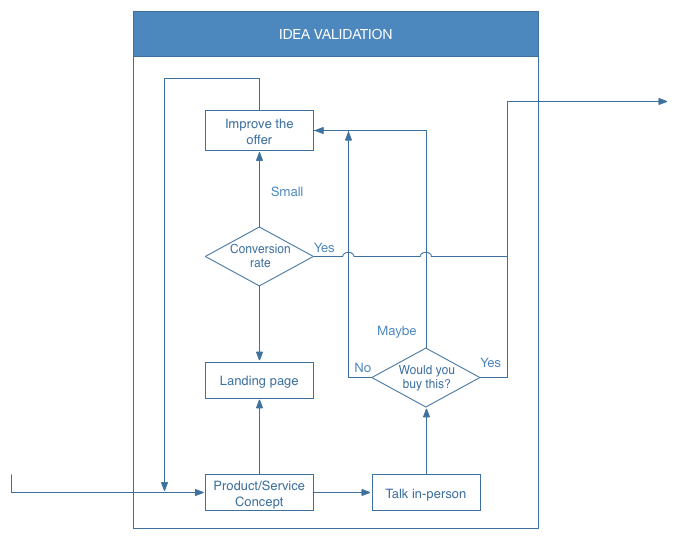
In the previous stage, you have validated your market. Now, you can start with this stage only if your previous market validation process proves that you have a market for your business idea, it is big enough, there are starving customers for your solution, and they are willing to pay you for the solution. Still, your solution is only in your head as a possible business idea. So, you don’t have a product or a service to offer to the market, and you haven’t designed or built anything yet.
At this validation stage, you want to be sure that it is worth spending time, money, and effort. Additionally, you need to go one step further and design and build your primary product.
Use a landing page for idea validation.
You can start with a simple landing page. But before you start building a landing page, translate the features of your product into customer benefits. Using these benefits, you can quickly begin making your total offer. Be sure that your landing page will have the following:
- Your total offer with short descriptions of customer’s benefits;
- Order form, subscription form, or phone number that visitors can use to take the first action on a page.

Your goal is to measure and check if there is enough interest in the problem for your customers. The best way to measure interest will be through conversion rates. You can calculate the conversion rates by the following formula:
Conversion rate = The total number of visitors / The number of visitors that take action.
For example, if you have generated 1000 visitors to your landing page, and 50 of them order your product or subscribe to your list to receive information about when they can buy the product or call you on the phone, your conversion rate will be 50/1000 = 0.05 or 5%. The higher this number, the higher your business idea will have potential.
Related: 31 Startup KPIs and Metrics to Measure with Examples
If your conversion rates don’t pass the process, you will need to improve the offer.
If you use pay-per-click ads, you can quickly calculate how much cost you will have per potential customer. So, you slowly build your product and connect different dots related to marketing and sales.
🚫 Warning
Read more about the sales funnel and its most important metrics, including conversion rates.
Validate your ideas through in-person interviews (customer validation interviews).
The second test you must implement at this stage is to conduct customer validation interviews. However, the customer validation interview will require talking with them face-to-face.
With such an interview, your goal is to collect qualitative data and check if your potential customer will buy such a solution. In many cases, they will not tell you directly that they will not buy from you or don’t want your solution. So, your job will be to analyze their non-verbal communication while you explain your product/service concept to them.
The answers you can get from such an interview can be:
- No, I will not buy your solution.
- Maybe I am not sure now.
- Yes, I will buy it for sure.
Your job through these tests and interviews is to tweak and improve the product/service concept. You will not stop until all interviewed customers are in the “yes” group.
When your business idea passes these tests, it passes the idea validation process. Now, you are ready to move forward to the last stage of the validation – the product validation stage.
3. Product validation stage
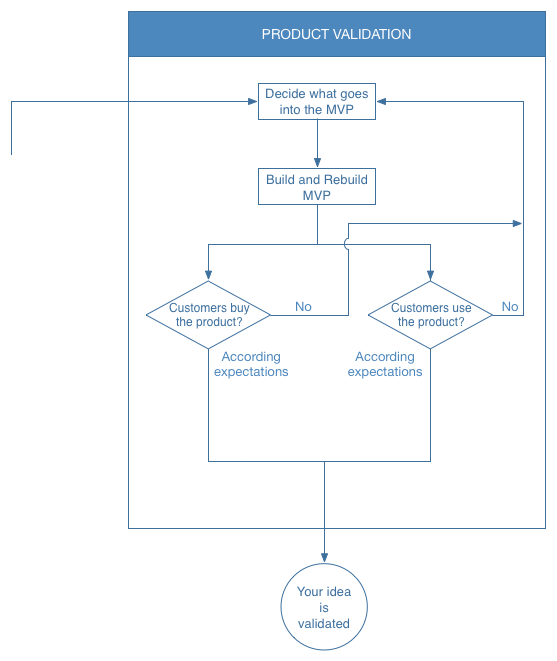
The product validation stage is the last stage in the process, during which you validate a business idea to be 100% sure that it will succeed.
When you come to this stage, you are already sure that there is enough of a big market for your product/service. People are starving for a solution and are willing to pay you. Additionally, you are sure that there is enough interest for a potential product through the idea validation phase. Also, you want to ensure that people will buy from you.
You need to acquire early adopters for your MVP through different forms of teasing. In the previous stage, you already surveyed potential customers or potential customers with whom you talked in person. Before you launch your MVP, it is important to have a critical mass of testers and early adopters. You need to get enough feedback from them to validate your MVP.
When launching your MVP, it is important to ask for payment on day one. This allows you to analyze your pricing model and determine if you need to change anything. Your prices will impact your sales quantity, income, and product profitability.
Related: 6 Tips to Help You Securing Startup Investment for Your Business
Decide what to include in your Minimum Viable Product
You will need to build an MVP (Minimum Viable Product) at this stage. MVP is the smallest thing you can make to start validating the product. On the other side, it is important to work on your MVP. Include all desirable functionalities you have approved from the previous two stages in this validation process. In such a way, you can prove or disprove your business idea.
At this stage of the validation process, you will first need to decide what to include in the MVP. So, you must check all the information you collected from the previous two stages through analysis, surveys, and interviews. The purpose is to use this analysis to decide what features to include in your first MVP and what needs to contain your total offer. Cut everything out that previous stages did not bring substantial value to the customers.
As an MVP, you can use wireframes, prototypes, and mock-ups. When you validate the business idea, you want to get a strong positive reaction from customers at this stage. You have already invested enough time and effort in the whole process, and you don’t want to screw up at the end.
Do the customers buy and use your product (MVP)?
When it comes to product validation, you must do the two most important things and measure them. The first one is to check if customers buy your product or service or are only interested in a solution but not ready to buy yet.
Pre-selling is an excellent way to validate the product, gain experience, and prepare yourself for more successful launches that you will use when you validate the business idea. So, you must define minimum success criteria, like if 3 of 10 generated leads to purchase your solution, then you have validated your MVP.
Remember that minimum success criteria must be based on costs per lead, costs for product development, manufacturing and logistics, and profit you would like to generate.
The second important measure is related to how your customers use the product or service as an MVP at this stage.
- How much time do they spend on your product?
- How do they use your product, and are they satisfied with it?
- Are they falling in love with your product?
- Are they using all features or only some of them?
You need to check if these two measures at this stage prove your expectations related to the purchase and how customers are using the product. Remember that you cannot expect everything to be ok and pass this stage for the first time.
In most cases, you base your expectations on assumptions, and now you will get the facts. And facts aren’t the same as expectations based on assumptions. You must tweak your features and total offer and rebuild your MVP. In such a case, you will have not one MVP but several until you achieve the results you expect.
When you come to the final MVP that passes the customer’s control, you can say that you have a validated business idea.
Idea Validation Success Factors
The question is how you will know that you are on the right track to build a successful business.
So, here is a checklist of what you need to check:
- You understand customer needs. The success of idea validation depends in large part on your target audience and their needs.
- You have validated problem-solution fit. Your idea should address a real problem that customers are facing and provide a real solution that meets their expectations. This can be achieved by getting feedback from the target market and ensuring that your product effectively solves their real pain points.
- You find strong evidence of demand. As you already see, idea validation involves assessing the demand for your product or service in the market. You can do this by analyzing competition, conducting focus groups, or running pre-launch campaigns to measure interest and collect data on customer behavior.
- Feasibility. It’s important to consider the feasibility of your idea before proceeding with it. This includes evaluating technical, financial, or logistical challenges that may arise and developing a plan to address them.
- Your unique value proposition is validated. What sets your product or service apart from your competitors?
- Your idea is scalable. You must ensure that your business will grow and expand in the future.
- Your customers are validated. It is important to validate your idea with actual paying customers. How much are people willing to pay for it?
- Your marketing and sales strategy generate the expected results. How will you promote and sell your product or service?
- Sales and distribution channels. How will your customers get your product? Will you sell directly to them through an online platform, use a traditional brick-and-mortar store, or use wholesalers or distributors?



